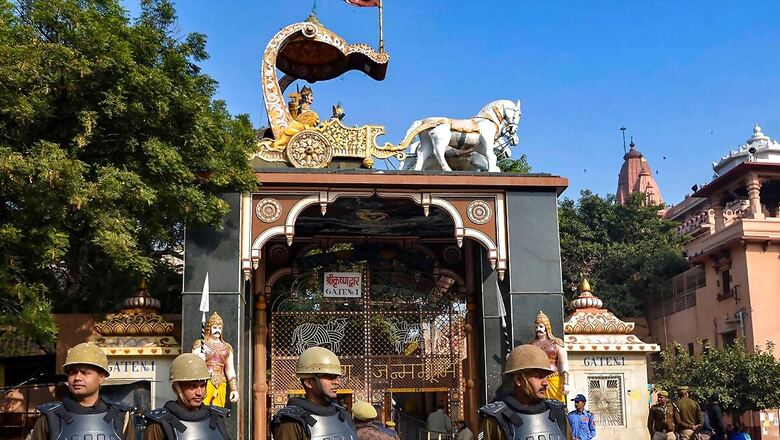
views
Gone are the days of Indian polity when contentious cultural issues could be decimated in public discourse by being pitted against development issues. The Mandir-Masjid debate cannot be set against poverty, inflation or unemployment for it to be shown any less important. The shift in socio-cultural consciousness is the defining factor of the last decade where cultural revivalism has taken centre-stage. It is reflected in the judicial quarters as well.
India’s oldest dispute – the Ram Janmabhoomi case – was settled by the Supreme Court’s Constitution Bench in favour of the Hindu side. Two other cases have kept the pot simmering. The Gyanvapi dispute and the Krishna Janmabhoomi case shall set the stage for a far more aggressive assertion of cultural rights through constitutional means.
If you have any doubt that the Gyanvapi dispute is legally any less significant than the Ram Janmabhoomi case, then the latest plea seeking the survey of the entire Gyanvapi mosque by the Archaeological survey of India should answer all your doubts.
The case is no longer just about the right to worship Ma Shringar Gauri in one of the areas inside the mosque complex. The case, per se, escalated legally, and in public, once the video of a disputed Shivling in the ‘wazookhana‘, reservoir where devotees carry out ablutions before offering namaz, went viral.
The area has been sealed by the Supreme Court keeping the sensitivity of the issue in consideration. The Hindu side wants the issue to be settled conclusively – whether the disputed structure is a Shivling or not. The order of carbon dating was put on hold by the Supreme Court because the Centre wanted to ensure that no damage shall be caused to the structure.
In another development, all petitions in the Krishna Janmabhoomi case have been transferred to the Allahabad High Court. The Hindu side wants the Shahi Idgah Mosque to be evicted from the temple premises, disputing the sanctity of the earlier agreements reached between the Hindu and the Muslim sides.
Right now, both cases are at a critical juncture. The transfer of all petitions in the Krishna Janmabhoomi case to the High Court is a déjà vu for anyone who remembers the history of the Ram Janmabhoomi case.
India’s diabolical historical context of invasions, destructions versus cultural infusion and co-existence presents a complex social and legal problem before the courts. The courts are forced to skim through mythology, history, religious texts to find ‘evidence’.
Perhaps the solution to these disputes should have been purely political, outside the domain of the courts and judiciary. But the reality of Indian politics deems it impossible. The halo of the courts, the might of justice and the compliance to the whip of the constitutional courts is the best political subterfuge for the winners and the losers in this prestige battle of communities.
So, rest assured, even these two critical battles in Kashi and Mathura shall be decided by the courts of this country, and not by any amicable political settlement.
Coming back to the Gyanvapi dispute, carbon dating or other scientific method shall be used to determine whether the disputed structure inside the ‘wazookhana’ is a Shivling.
It remains to be seen how conclusive such a method shall be. For a court to reach a conclusion on this matter shall be another difficult task. There is no such precedent. It’s one thing to have the ASI look at artefacts or the architecture like in the Ram Mandir case, but there is no precedent when a court has embarked upon the exercise of finding the presence of the deity itself.
If the presence of the Shivling or deity can be established inside the mosque complex, then the deity shall have the property rights. Such rights are legally recognised and protected. The scope of this litigation is wide and all encompassing. It is not about just one area of the mosque complex. It is about the entire mosque complex. The interim orders of the Supreme Court to seal the area are just a make-shift arrangement. Both sides shall seek finality.
Similarly, the transfer of all Krishna Janmabhoomi plaints and suits to the Allahabad High Court for original trial marks the beginning of a long legal battle ahead. But the shift to the High Court gives the trial a certain structure, avoiding multiplicity of plaints and delays. The trial will now proceed in the direction of some degree of finality.
In a certain sense, it’s unfair that the courts are countenanced with such political or religious questions. The judiciary has so far taken the task on its chin and delivered. Ram Janmabhoomi was not the last of such disputes, neither will Gynavapi or Mathura be the last ones. Ghosts of the past, historical injustices which were closeted and ignored are here demanding answers. They must be addressed. Reconciliation with tumultuous past is never easy. A churn is inevitable. The battle for Gyanvapi and Mathura is just another chapter in the temple reclamation movement. It is indeed not the last one.
My Lords on the bench will have to decide for the rights of the Lords residing in the temples.




















Comments
0 comment